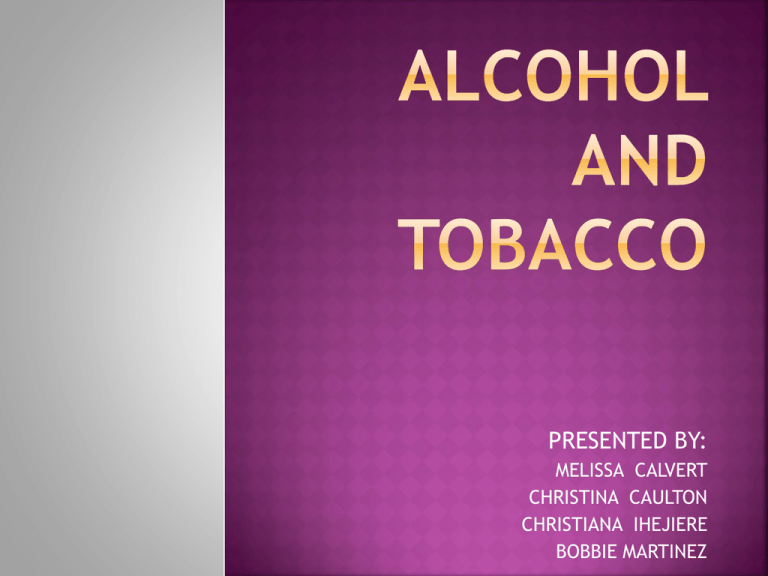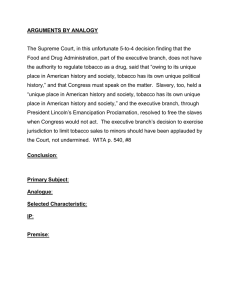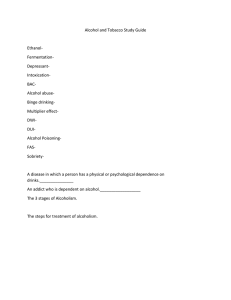
PRESENTED BY:
MELISSA CALVERT
CHRISTINA CAULTON
CHRISTIANA IHEJIERE
BOBBIE MARTINEZ
1.
Most: 9 out of 10
2.
Half: 5 out of 10
3.
Very few: Less than 1 out of 10
1.
Most: 8 out of 10
2.
Half: 5 out of 10
3.
A few: Less than 2 out of 10
1.
Most: 8 out of 10
2.
About half: 5 out of 10
3.
A few: 2 out of 10
Affects
every organ in your body
Central nervous system depressant that is
rapidly absorbed from the stomach and
small intestine into your bloodstream
Metabolized in the liver, but the liver can
only metabolize small amounts at a time
so the excess circulates around your body
Regular beer
1.5 “standard drinks”
Table wine
1.5 oz (40% alcohol)
Hard liquor
12 oz (5% alcohol)
“Standard drink”
5 oz (12% alcohol)
12 oz malt liquor
1.2 T pure alcohol
Premixed
drinks that combine alcohol,
caffeine, and other stimulants
Higher alcohol content than beer (5%-12% on
average vs 4%-5% for beer)
Caffeine content usually not reported
Caffeine can mask clues that tell someone
how intoxicated they are – you can become
more intoxicated because you are drinking
more alcohol than you realize
May lead to more life-threatening and hazardous
behaviors like alcohol poisoning, sexual assault,
and riding with a driver that has been drinking
Colorful packaging
Watermelon, blue raspberry, lemon-lime
Look like energy drinks
As much caffeine as a cup of
coffee or more
21 years or older
5 or more drinks on a single occasion
for men or 4 or more drinks on a
single occasion for women, usually
within 2 hours
School problems – higher absences, poor/failing grades
Social problems – fighting, lack of participation in activities
Legal problems – arrest for driving/hurting someone while drunk
Physical problems – hangovers, illnesses
Memory problems
Unwanted, unplanned, and unprotected sexual
activity
Physical and sexual assault (rape)
Higher risk for suicide and homicide
Abuse of other drugs
Death from alcohol poisoning
THAT’S A LOT OF PROBLEMS!
Impaired brain function – poor judgment,
reduced reaction time, loss of balance and
motor skills, slurred speech
Dilation of blood vessels – you feel warm but you
are quickly losing body heat
Damage to developing fetus
Higher risk of car crashes, violence, other
injuries
TRUE
FALSE
TRUE
Most kids that see themselves going to college and
living past 35 (yes!) DON’T drink or smoke – they
will be around to enjoy their success!
Expectations can be right on, but often they are totally off, especially when
talking about alcohol. Do you think using alcohol has positive consequences?
Read below…
To have more fun and excitement?
To fit in better?
Reality: alcohol relaxes your judgment so you can say and do things you regret
To be funny?
Reality: throwing up, being visibly drunk, and saying stupid things aren’t attractive
To relax, feel less shy or nervous?
Reality: if you are already feeling down, drinking can make it worse
To be more attractive?
Reality: acting stupid, throwing up, and starting fights doesn’t impress people
To feel good or improve your mood?
Reality: most teens don’t drink
To impress others?
Reality: more stressed and depressed
Reality: people not drinking usually think that drinkers are not funny at all
To solve your problems or forget about them?
Reality: alcohol messes up your thinking and can lead to even more problems, like
addiction
That tobacco use includes smoking and smokeless tobacco
(chewing tobacco and snuff)?
That more than 80% of adults that smoke began smoking
before they were 18 years old?
That teen smokeless tobacco users are more likely than
non-users to smoke cigarettes as adults?
That more high school students are reporting using
smokeless tobacco products?
That bullying, being bullied, or being depressed can bring
someone to start smoking and/or drinking?
If you have self-control problems you are at greater risk
for using alcohol and tobacco?
% of high school students who were cigarette smokers in
2009?
17.2%
% of middle school students who were cigarette
smokers in 2009?
5.2%
% of high school students who were smokeless tobacco users
in 2009?
6.7%
% of middle school students who were smokeless
tobacco users in 2009?
2.6%
High
risk sexual behavior
Use
of alcohol
Use
of other drugs
Cancer
Lip, mouth, pharynx, esophagus, pancreas, voice box,
lung, cervix, bladder, kidney
Lung cancer 23 times higher in men and 13 times
higher in women smokers vs nonsmokers
Highest in African-American men
Heart Disease and Stroke
Respiratory Health
Coronary heart disease, doubles risk for stroke,
narrows arteries, increased risk for heart attack
Chronic lung disease; secondhand smoke is no better
Smoking during pregnancy
Complications, premature birth, low birth weight
babies, stillbirth, sudden infant death syndrome
(SIDS)
Did
you know that…
Every year tobacco companies spend
billions of $ on advertising and
promotion
U.S. consumers (us!) spend billions of $
buying tobacco products
Tobacco use then costs the U.S. billions
of $ in medical expenses and lost
productivity
In 2006, cigarette companies spent
$12,400,000,000 ($12.4 billion)
on advertising and promotional
expenses in the U.S. alone!
This amounted to almost
$34,000,000 per day in marketing
expenses!
In 2006, U.S. consumers spent:
$83,600,000,000
On cigarettes
$3,200,000,000
On cigars
$2,600,000,000
On smokeless tobacco
Nicotine
in tobacco is addictive
Nicotine narrows your blood vessels and puts
added strain on your heart
Smoking can wreck your lungs and reduce
oxygen available for muscles used during
sports
Smokers suffer shortness of breath almost 3
times more often that nonsmokers
Smokers run slower and can’t run as far,
affecting overall athletic performance
Cigars and spit/chew tobacco are NOT safe
alternatives!
Yuck!
Tobacco smoke can make hair and
clothes stink
Tobacco stains teeth and causes bad breath
Short term use of spit/chew tobacco can
cause cracked lips, white spots, sores, and
bleeding in the mouth
Surgery to remove oral (mouth) cancers
caused by tobacco use can lead to serious
changes in the face.
Sean Marsee, a high school star athlete who used
spit tobacco, died of oral cancer when he was
only 19 years old!
Know the truth!
Most teens, adults, and athletes DON’T use tobacco
Make friends, develop athletic skills, control
weight, be independent, be cool…play sports
Use older, popular adolescents that DON’T smoke
as role models and remember the consequences
even as you get older!
Don’t burn money on tobacco
Spend it on music, apps, clothes, video games,
movies, sports, hanging out with friends
Get involved
Make your team, home, and school tobacco-free;
teach others; join community efforts to prevent
tobacco use


